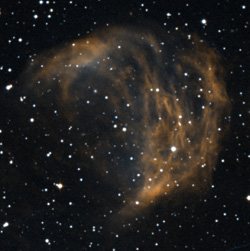 This
is a low surface brightness planetary nebula that you won't often
find mentioned in the popular literature. A target for larger
apertures without a filter, Abell 21 may be accessible to
instruments as small as 8-inches with an OIII filter in place. This
is a low surface brightness planetary nebula that you won't often
find mentioned in the popular literature. A target for larger
apertures without a filter, Abell 21 may be accessible to
instruments as small as 8-inches with an OIII filter in place.
It isn't obvious from
the photographs on this page, but the brightest portion of this
nebula is the southwestern end (top left). You should
concentrate your search on this area. Use low magnification.
Look for a bar-shaped diffuse area with none of the color or detail
of the images shown here. Once found, try to trace the nebula
toward the bright star on the bottom right.
I spent some effort
finding this one last year with my 18-inch f/4.5 without an OIII
filter. Without the filter only a slight, roundish haze was
perceptible at 94x. Although considerably easier to detect
than some of the fainter diffuse planetaries such as JnEr 1, it
isn't exactly obvious.
With the OIII in place
it became easy! Averted vision gives the impression of a
large, roundish glow. The brightest portion of the nebula
appeared as a luminous bar running east/west. More haze
surrounds the 11th magnitude star GSC 00776-1339. Taken
together, they take on a sort of elongated "P" shape, very
much reminiscent of Thor's Helmet (NGC
2359), although the latter is considerably brighter.
I should have attempted
more magnification than 94x. In photographs this nebula is
composed of multiple arcs of nebulosity which may have become
apparent at higher magnification. 
The field in a 8-inch at 50x.
North is down and east is to the right. |